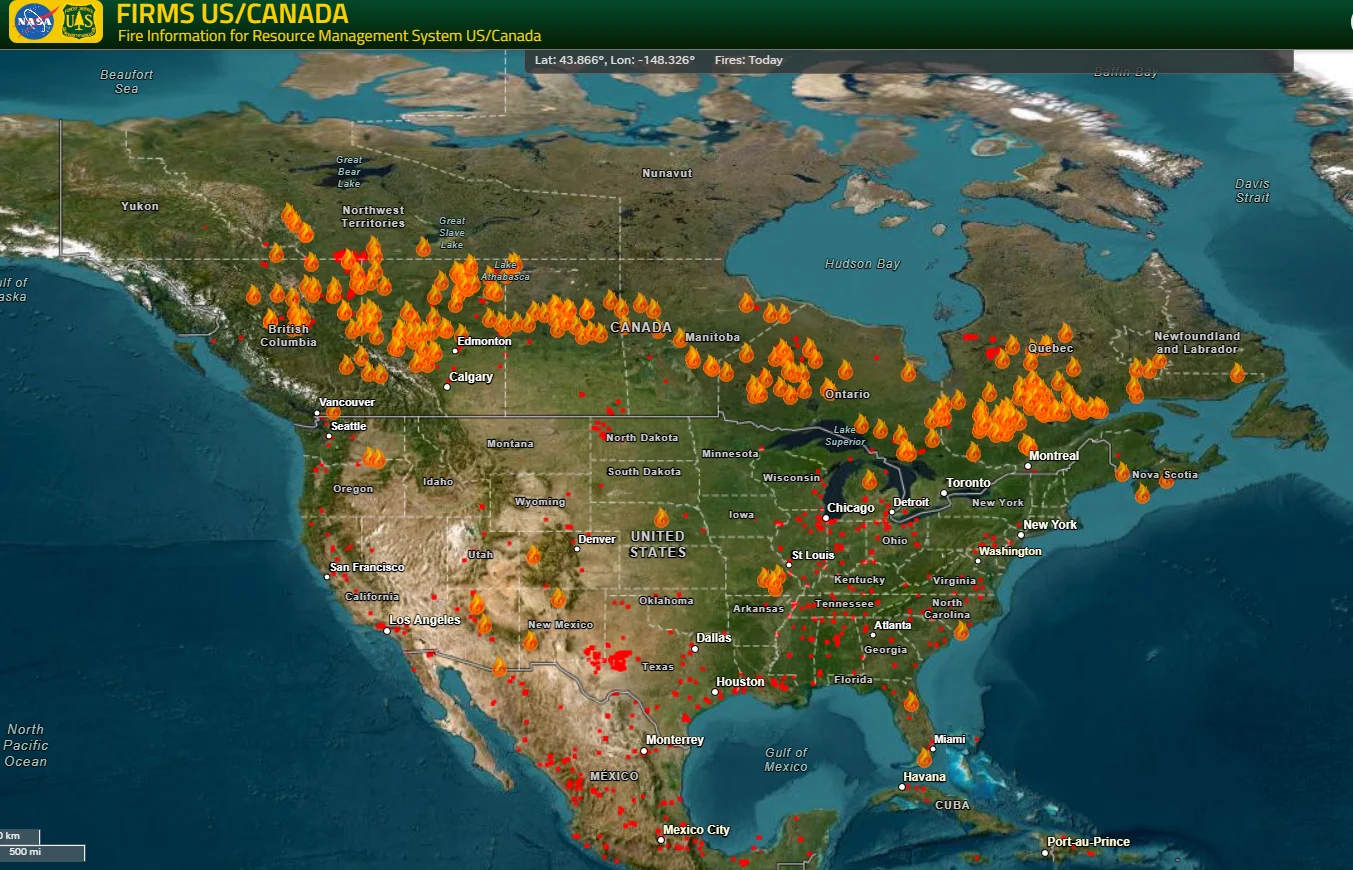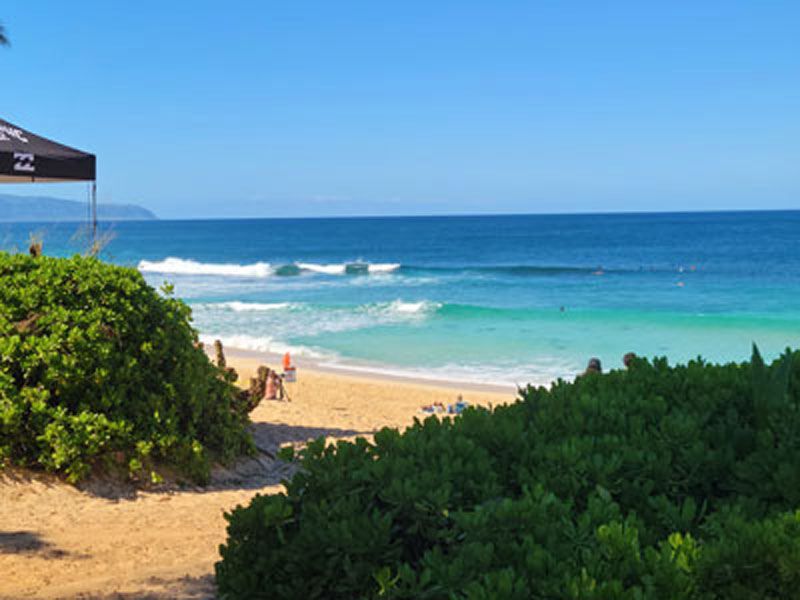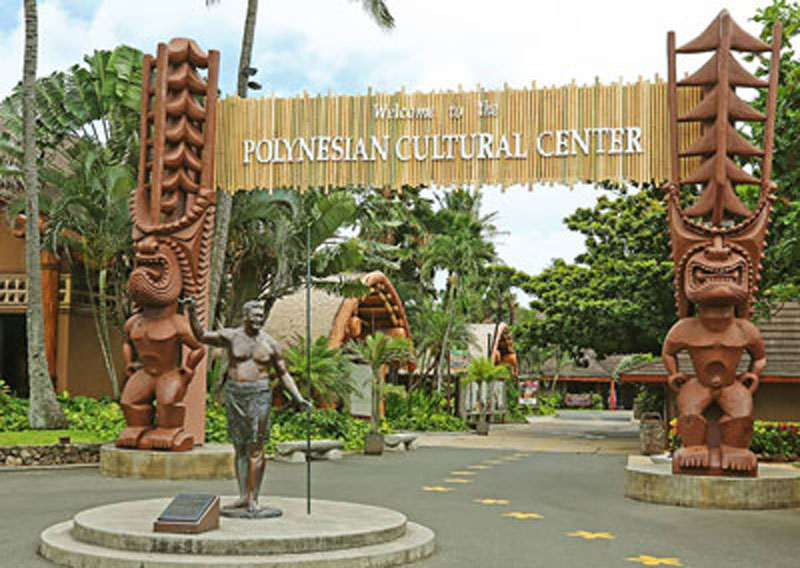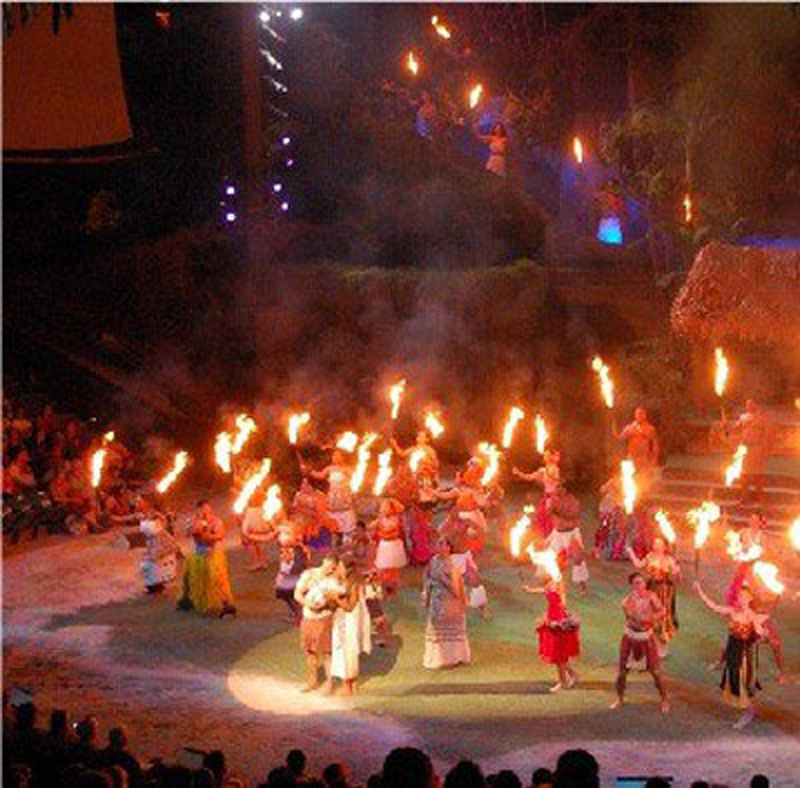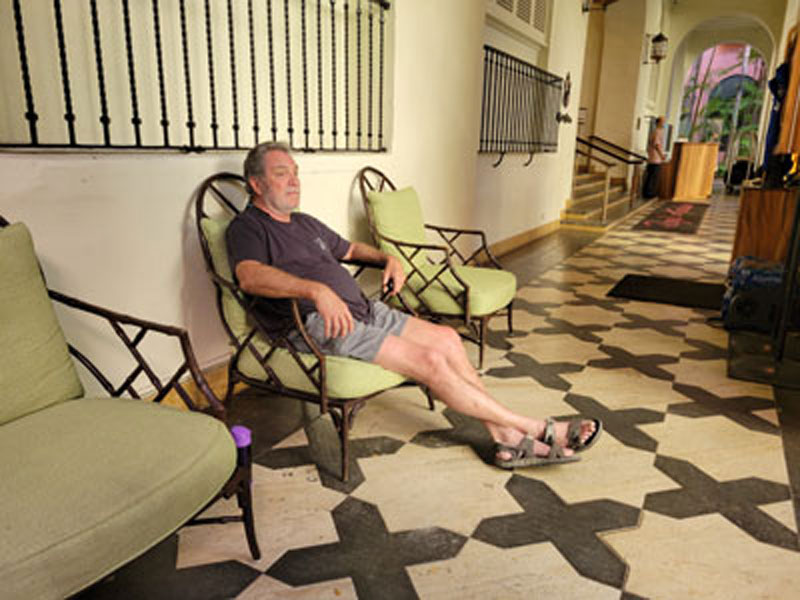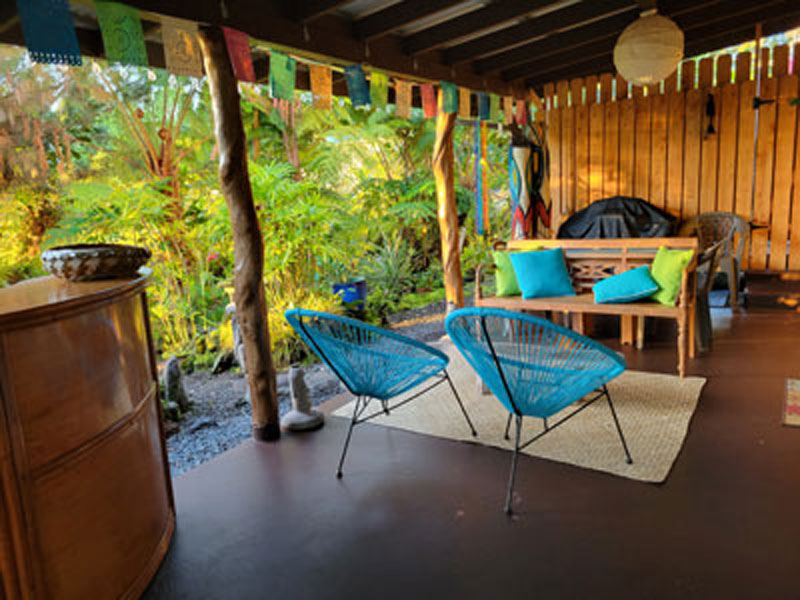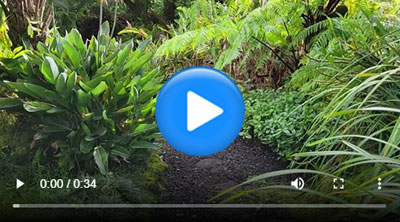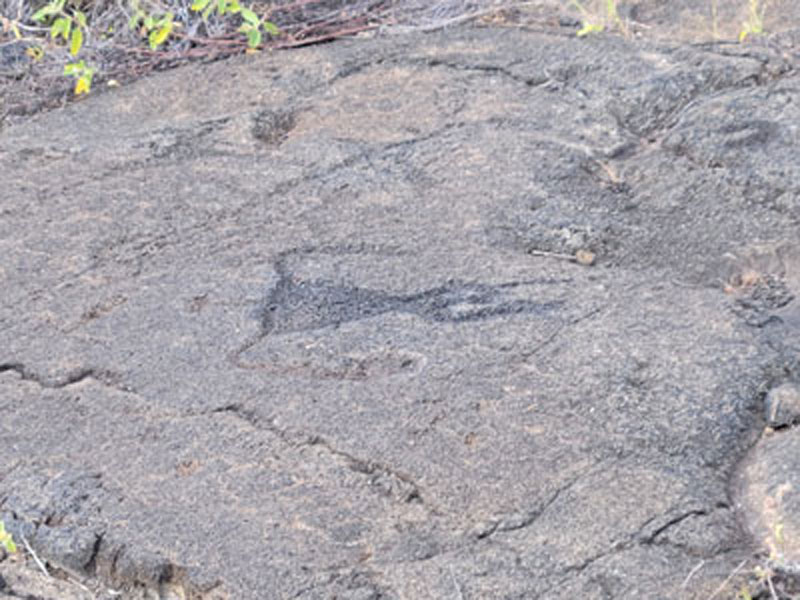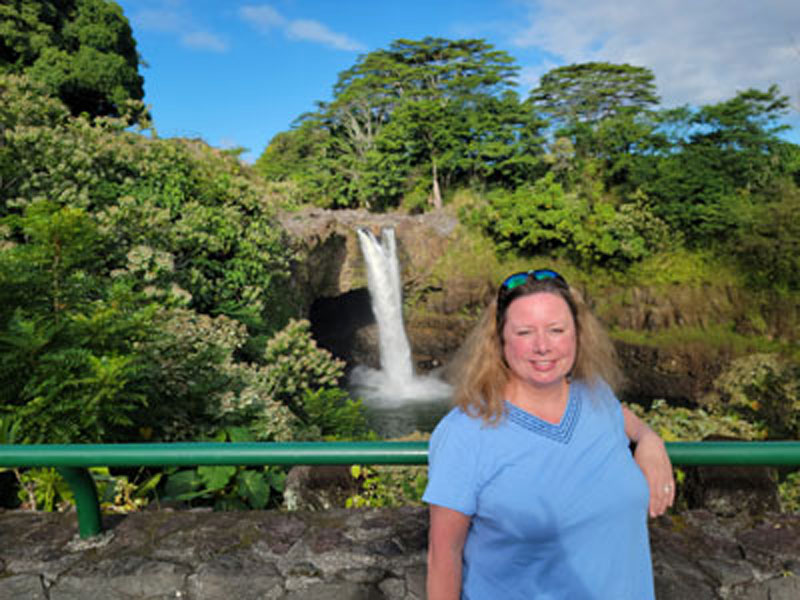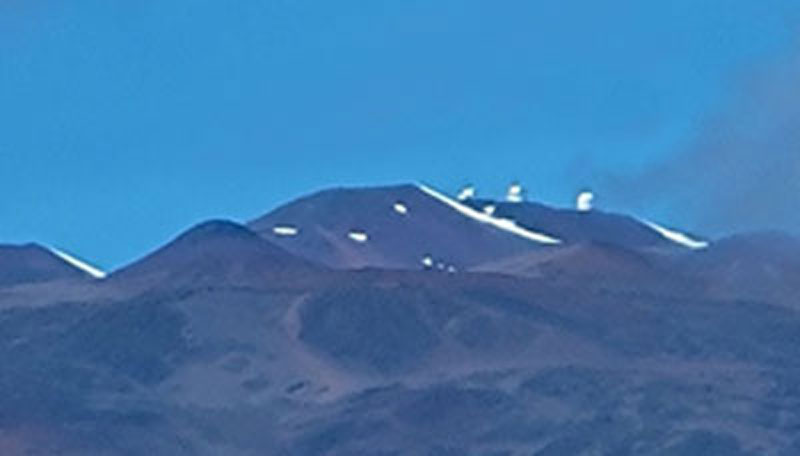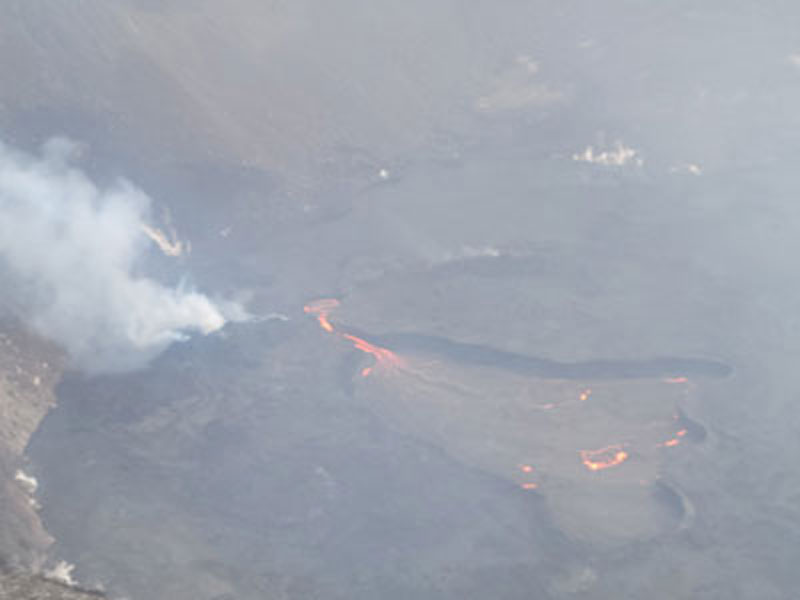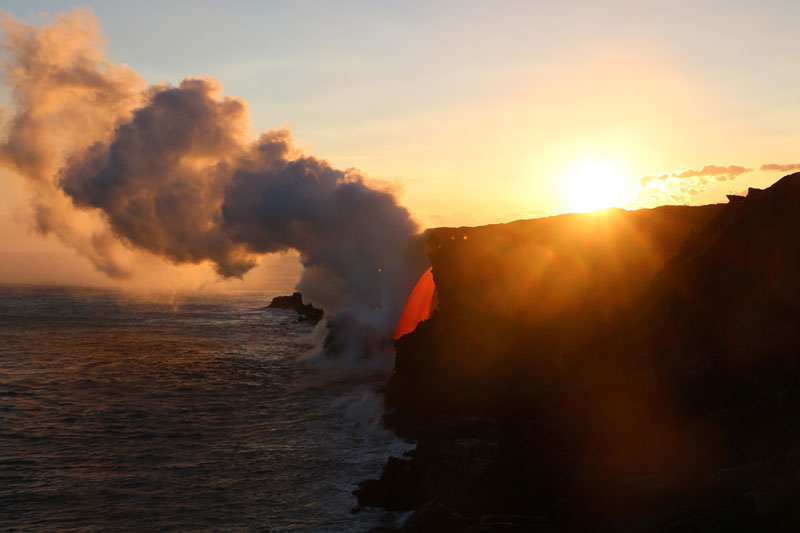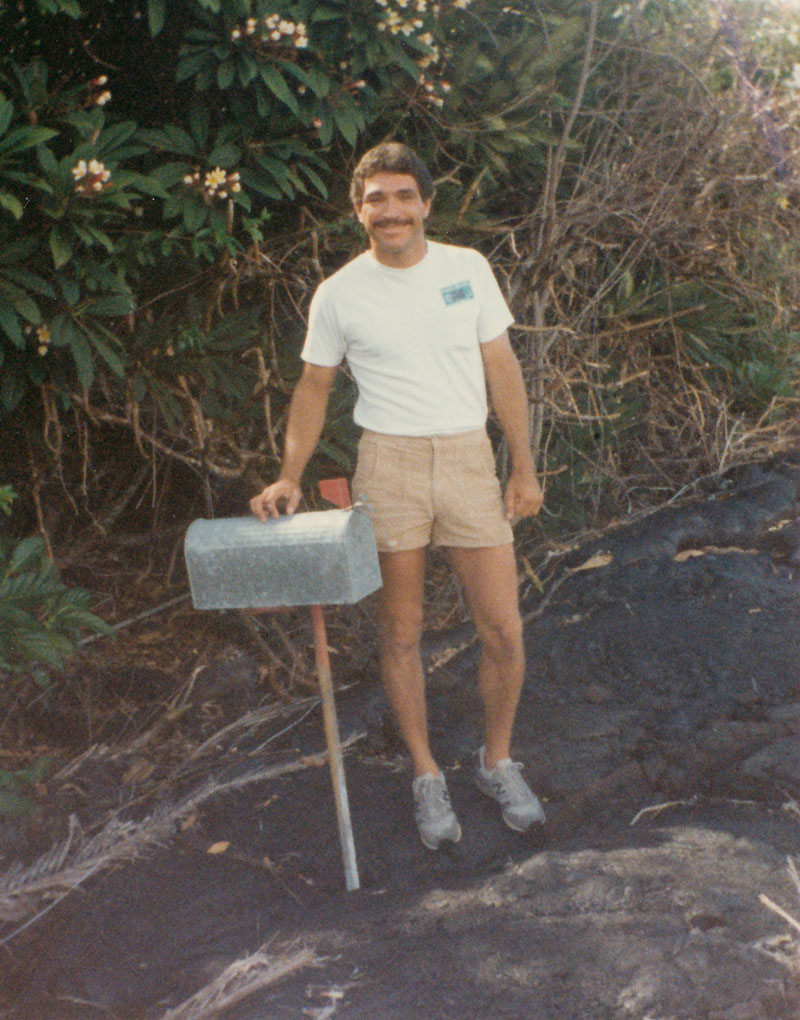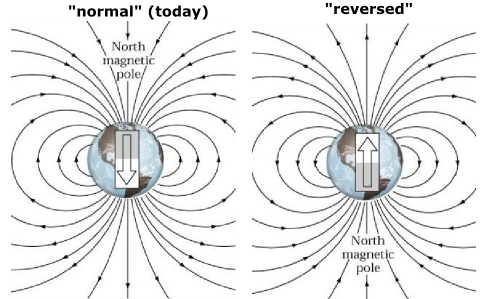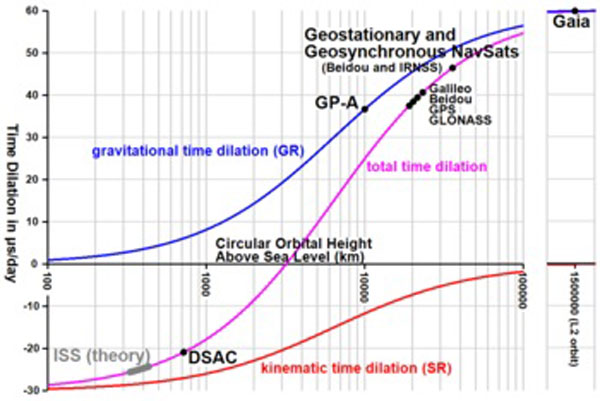Hawaii
February 2022
2-2-2022 through 2-10-2022
Most do not know this, but Mark and Beth never had a proper honeymoon. Over the past 15 years, since they got married, Mark's father was ill and passed, Beth's mother became ill and passed, their little dog got old and needed attention. There was always something keeping them from traveling very far from California. Since the Dinky Dog's passing, Mark and Beth have decided to take some trips farther from home than Las Vegas. Anyway, this trip, and others to come, are intended to fill that gap.
(Wednesday 2/2 Day 1)
The trip started off in such a way that I must tell you about it. Beth ordered a Yellow Cab to pick us up at 5:45 AM and take us to Long Beach Airport - 2 miles - just a few minutes. 15 minutes late, here comes a van, one headlight out, clanking down the street toward us. The door slides open and very happy foreign person mumbles howdy. We got the only seat in the van. The back seat all covered with duct tape - slippery to sit on too. Nothing to hold on to - off we went. The guy was driving very fast and was one of those type of drivers who puts the brakes on way too late so stopping is a hang on to everything moment. Halfway to the airport, hanging on to anything I could grab onto, I told Beth I felt like I was in La Paz, Bolivia. Everything about that 10 minute experience was 3rd world. Worse! I never expected to have that kind of taxi ride anywhere in the USA. So, Beth and I started the trip shaking our heads and alert on adrenaline.
We flew Hawaiian Airlines from Long Beach to Honolulu Airport on O'ahu, Hawai'i. We flew on an Airbus 320neo aircraft. We paid for extra comfort seats and the flight was comfortable. It was a 5.5 hour flight from Long Beach to O'ahu.
Apparently newer aircraft like the Airbus A320neo and the Boeing 737max, neither have the old style MUX (Multiplexor) nor entertainment systems of old. No longer is there a screen on the back of the seat for you to enjoy movies and such. Now, in order to watch movies or listen to music, you must download an app on your phone or tablet, before you have to go into airplane mode. The entire entertainment system is this app. The only thing you will find on the back of the seat now is a USB plug. Bottom line, you need to have all the correct adapters for your phone so you can be charging and listening to the audio via the old style headphones. Of course you can get fancy and use a bluetooth headset. I could not find mine so I had to do it the old-fashioned way, with an adapter, so I could use the old style headset. Anyway, I give all the credit to Beth for having purchased the proper adapter cords so we could enjoy the new entertainment system app via our phones.

We arrived on O'ahu at Honolulu International Airport at 12:50 PM. We took the bus to the rental car area and picked up our Hertz rental car. It was a Ford Edge compact SUV. It was gutless in eco mode and only a little better out of eco mode but it was roomy and got us around the island in fine shape. I think we only used not quite one tank of gas and that was a blessing because gas was between $4.50 and $5.00 per gallon.
The weather was warm. It was around 75° F at night and 80° F in the daytime. Shorts and sandals were in order. It was a good idea that we had said shorts and sandals in our back packs so we could change in the airport, before going outside. We had no rain.
We drove to the Airbnb in Waikiki Beach. It was a block or so from the beach and a little east of the Royal Hawaiian Hotel. This place is in a high rise building and it took Beth a while to figure out how to get in. But she finally figured it out. We were on the 17th floor with a good view of Waikiki Beach.
We decided to look around the Waikiki Beach area, in the neighborhood of the Airbnb, for a while. We purchased some BBQ chicken and fruit from a takeout store and that was dinner. We got to bed early. Tomorrow was going to be a busy day.
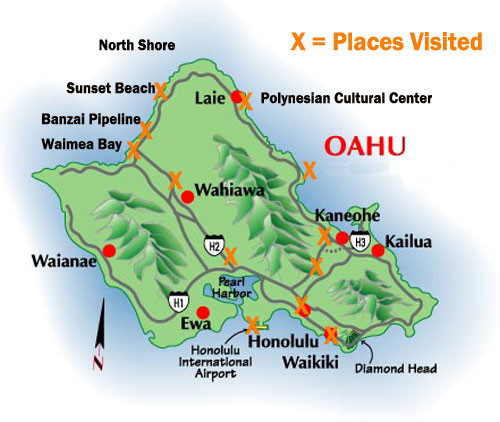
(Thursday 2/3 Day 2)
We drove to North Shore and went to Waimea Bay, Banzai Pipeline, and Sunset Beach. We spent the entire morning and early afternoon at the beach.
It was a really small day at Pipeline. They even suspended the tournament because it was so small. A Hawaiian, that reminded me of my surfer friend Chuck, talked me into paddling out with him on one of his boards. I got a couple of waves but only one got on video.
We stopped at a couple of beaches along the north shore like Sunset Beach. We found some very beautiful beaches with very few people if any.
At the old Kahuku sugar mill, between Pipeline and the Polynesian Cultural Center, we found a shaved ice stand with a bunch of old machinery displayed around a park area. So, Beth got to try shaved ice for the first time. It was OK for a while but as we got to the bottom it just became to sweet and neither of us could finish it.
We changed our clothes and headed to the Polynesian Cultural Center for a tour, luau, and show. The Cultural Center is only about 15 minutes from Pipeline.
We arrived at the Cultural Center around 2:30 PM. It was perfect timing to visit some of the "islands" before attending the luau that started at 4:30 PM. The Cultural Center is sort of like a little Polynesian Disneyland. Each of the 6 Polynesian islands are represented by their own replica village with buildings, dress, dance, and rituals associated with the various islands.
Beth learned the prevailing story behind the "Shaka"  as its story is displayed at the entrance to the Polynesian Cultural Center.
as its story is displayed at the entrance to the Polynesian Cultural Center.
The origin of the "Shaka" symbol is difficult to pin down. There are in fact many versions of the story but here is the most popular. The one thing that everyone agrees on is that the man behind the legend is Hamana Kalili. Kalili lived on the east side of O'ahu during the early 1900s. Most of the stories have him losing his three middle fingers in a sugar mill accident. The stories mostly tell that after the accident the plantation owner gave Kalili a new job as the security officer for the train that used to run between Sunset Beach and the Kaaawa sugar mill. His all-clear gesture of waiving his hand with only thumb and pinky would indicate that the train was free of unwanted train jumpers and that gesture is what would become today's Shaka. Eventually the train jumpers adopted that gesture, and it became their signal to indicate Kalili was not around or not looking, and the coast was clear for them to jump on the train. Kalili's story would be exaggerated when he tried to keep kids from mischief. The name "Shaka" is reputed to have come from Kailili telling kolohe (kids) that while swimming one day a shark had bit off his fingers during a fierce battle for his life, but with his thick accent it sounded like he was saying "the shaka bit me" and so goes how the moniker "Shaka" became a part of history.
Kalili also served as "king" of the church fundraiser - complete with a hukilau, luau and show - that was held annually for years until the 1970s. Photos show him greeting attendees with his distinctive wave.
Whatever its origin, in Hawaii, the "Shaka" sign is used everywhere by everyone, and it carries a lot of different meanings. It can be used to say "Thanks" or "Cool" or "Yeah", it can also mean "Hello" or "Goodbye". But when asked to define the sign, Hawaiian people say that it is a sign of Aloha i.e. appreciation and love and that for them it is something that is part of their daily life.
After learning about the "Shaka" and touring the various "islands" that make up the Cultural Center we went to the luau. The luau is held in a large covered open-air semicircular multilevel area. There is entertainment going on during the luau and the luau is all you can eat. This is a surprisingly large event. There were 4 separate serving stations around the back of the event area. Mark had several servings of the chocolate ice-cream. Beth tried poi and was not amused.
We then attended the Breath Of Life Show that started at 7:30 PM. We had 2nd row seats in the huge open-air auditorium. The luau was good and the show was well acted and choreographed. We had a very enjoyable time.
We learned that the proceeds from the Polynesian Cultural Center pay for the students' tuition at BYU which is adjacent to the Cultural Center. All the BYU students work at the Cultural Center while attending school doing any one of the various jobs at the Cultural Center including acting out the parts of actual Polynesians from various islands.
(Friday 2/4 Day 3)
In the morning we drove back to the Polynesian Cultural Center so we could see the coast that we had missed driving back to the Airbnb from the Cultural Center the night before. We were glad we did because there were some awesome sights we missed while driving in the dark.
There is even a tunnel that goes through a mountain of lava rock.
We then drove to the Royal Hawaiian Hotel and dropped off our luggage.
We returned the rental car and walked back to the Royal Hawaiian - about an 8 minute walk. We checked in around 2:00 PM.
We walked around Waikiki Beach and had dinner at sunset at the Hula Grill directly above the famous Duke's restaurant and overlooking Waikiki Beach. The view was breathtaking and the sunset was, well you decide.
After dinner, while walking around Waikiki Beach, Beth got to play with a cockatoo that had a pretty good vocabulary.
(Saturday 2/5 Day 4)
We awoke early and Beth got us some of the famous complementary Royal Hawiian banana muffins. After making sure their beach digs were correct, Mark played tourist for a while. He talked to some friends on the mainland while enjoying the chairs overlooking the garden at the Royal Hawaiian courtyard while watching the sun come up. It was 5 star all the way.
We rented an umbrella with 2 reclining chairs right on the water on Waikiki Beach directly in front of the Royal Hawaiian and Sheraton Hotels. The pool was 30 steps away and the ocean was 5 steps away.
We spent the entire day on the beach drinking rum and cokes, playing in the water, and basking in the sun.
We went to the Cheesecake Factory for dinner. It was just a short walk from our room down a garden path. Beth had a salad and Mark had a breakfast meal. Both were large portions and good.
This would be our last night on the island of O'ahu. Tomorrow we would be off to Hawai'i - the Big Island - to visit the Kilauea volcano.
Interesting Note: It is thought that the Hawaiian Islands formed over millions of years due to the plate moving over a hot spot in the earth's interior for millions of years. The largest of all the islands, Hawai'i, has formed over the last 700 years.

(Sunday 2/6 Day 5)
We took a cab to the airport at 10 AM.
Our flight to Hilo, Hawai'i lasted about an hour - maybe less. This pilot must have been in a hurry. I have never taxiied so fast in an airplane. The aircraft was a MD 87 also known as a Boeing 717, an airplane manufactured while Mark and Beth both worked at McDonald Douglas / Boeing. These planes are basically longer and upgraded DC-9s. Everyone remembers the old DC-9's.
In fact, it is highly likely Mark was working on the flight ramp while this particular MD 87 was being flight tested for delivery at Long Beach. The pilot must have been taxiing at least 60+ miles per hour, turned on to the runway, and off we went. The same thing happened when we arrived at Hilo. He hauled ass from the runway to the gate.
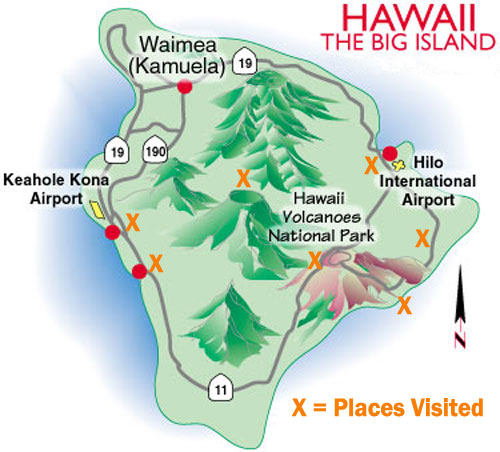
We arrived in Hilo at 1:30 PM. We walked across the street and rented a Nissan Rogue from Hertz. After a few blocks Mark detected a noise coming from under the hood, so after stopping at McDonalds, we returned to the rental building to get another car or stop the irritating noise. The lone rental agent opened the hood and determined the problem to be the loose plastic intake tube hitting the firewall. Armed with a roll of scotch tape, he tried to fix the problem by wrapping it with scotch tape. Mark looked at the problem and had an idea. Mark got a McDonalds cardboard sandwich box from Beth, folded it up, and wedged it between the loose plastic piece and the firewall. Problem solved even though the attendant had successfully applied scotch tape to the area. An E for effort but that dog wasn't going to hunt.
We drove to the Airbnb just south of Hilo and dropped off our luggage.
Beth explored the Airbnb yard area that has a perplexing number of these little tiny Coqui frogs that sound like bird dinosaurs screeching back and forth at one another all night long.

They actually produce 65 dB sound levels which is loud.
We drove to Walmart in Hilo and bought picnic food to take on our sightseeing journeys around the island.
We bought fast food at Jack in the Box and that became dinner.
The weather was cool. Mark was glad he took a sweatshirt. It was around 65° F at night and up to 80° F in the daytime. Hilo was definitely on the cooler side. Shorts and sandals were the attire but with a sweatshirt at night. We hit some rain in Hilo and around the volcano but not enough to keep us from doing anything. Of course, it was dry driving across the island and in Kona.
(Monday 2/7 Day 6)
We got an early start and drove to Volcano National Park. It was only a half hour drive to the entrance.
We took the north route to the top of Kilauea crater. Mark was disappointed because when he was here 40 years ago, you could sit on the edge of the rim and look down into the crater. You could see lava at the bottom and steam and gasses rising from it. Today, because of the 2018 eruption to the south, Kilauea's rim has collapsed all around in several layers and created a much larger crater. As I recall, 40 years ago, the crater was just over 1/2 mile across. Today it is 2 or more miles across and is oval in shape. Bottom line, you cannot get within several hundred yards from the rim and no way you can even see the bottom of the crater where lava continues to flow. Another disappointing part of crater rim was the building that housed many old pictures of past eruptions was destroyed by the 2018 eruption. It still stands but is closed because it sustained so much damage it is too dangerous to enter. In this building, 40 years ago, I distinctly recall seeing a large black and white picture of a woman with a fancy hat and dress standing next to a horse and buggy only a few hundred yards from a several hundred-foot plume of lava shooting straight up into the sky. I cannot find this picture today but one of the old rangers I talked to remembers the picture and thinks it may have been destroyed with the building in 2018. This destruction was not caused by fire or ash but by the earthquakes that shook the area for months. Hawai'i Volcanoes National Park is currently recovering from the 2018 eruption of Kilauea volcano. Much of the park has re-opened, but several areas are still closed.
Steam vents plume from this massive Kilauea crater, known as the home of Pele, the volcano goddess. In 2008, this crater was filled with a lake of lava that disappeared in 2018. Seismic activity caused by the crater walls falling into itself created a much larger crater. In May 2018, Halemaumau's volume was about 70-78 million cubic yards. It is now about 1.2 billion cubic yards. The crater floor has dropped more than 1,600 ft. Great respect should be paid at this sacred site.
On April 30, 2018, the lava pond from the Pu'u 'O'o Vent vanished and headed toward the Lower East Rift Zone. Pu'u 'O'o had been erupting, almost continuously for 35 years, since January 1983.
The below picture is from the north side of crater rim looking south. You can see some rising steam and gas and that is about it. We are standing as close to the crater rim as we could get. You cannot see much. The next 2 pictures are of Kilauea from the helicopter ride we took several days later. You will see where the steam and gas is coming from at the bottom of the crater some 1,600 feet below the rim with a lava lake flowing in red. It's hard to believe these pictures are all of the same place.

Looking at Kilauea from the south at 1000 ft. from a helicopter.

The lava lake inside Kilauea.

So, after being disappointed with the crater rim view, we took off to the south toward the ocean. Our next stop was Nahuku - the Thurston lava tube.
The lava tube Nahuku formed about 500 years ago. A lava tube forms when low viscosity lava forms a hard crust that thickens and forms a roof over the still-flowing lava. Lorrin Thurston, a local newspaper publisher, discovered Nahuku in 1913. Nahuku means "protuberances" in the Hawaiian language.
We then ventured further south toward the ocean, down the volcano, passing over several old lava flows that have occurred over the last 30 or more years.

Beth had been reading about the Nene bird (Hawaiian goose) that is resident all over the park and is endangered. We had yet to see even one. The birds mate for life and the death of one will cause the other to eventually die. We pulled into a vista turnout about halfway down the volcano and finally came upon a mated pair of these Nene birds. The funny thing is the rental car we had was black with a high finish. The birds could see themselves in the reflection and decided to attack the car. They would not stop until I got between them and the car. I thought I was going to be attacked by the male who was not happy with me.
We finally arrived at the ocean and walked the half mile to see the arch and the rugged coast.

On our way back up the volcano, Beth talked me into taking the 1.4 mile hike over 1.4 miles of lava to see some petroglyphs. It was exactly what you might think. A mile and a half over a bumpy, rocky, sharp, lava field.
After leaving the petroglyphs we were gassed. We drove back to Hilo and got Chinese food for dinner that ended up being not so good. I mean we ate most of it, and it didn't make us sick, but it wasn't all that good.
(Tuesday 2/8 Day 7)
We drove to Rainbow Falls, about 5 minutes from the Airbnb. Rainbow Falls is a waterfall located in Hilo, Hawai'i. It is 80 ft tall and almost 100 ft in diameter. The falls cascade over a lava cave that, according to legends, is home to the ancient Hawaiian goddess Hina, the goddess of the moon. The falls are part of the Hawai'i State Parks.
We then went in search of a black sand beach.
Beth found a black sand beach at Lehia Beach park. Although small, it was indeed a black sand beach.
Venturing further into the park, the black sand beach opened up into a true beach.
We drove to Pahoa and Panu and saw what is known as the Hippie town. We purchased a Slurpee at 7/11 and it was way better than shaved ice.
We then drove to Kona, across the island. It was a 1.5 hour drive

While driving across the island, we could see the observatories and snow atop the Mauna Kea volcano.
We drove all the way to the Puuhonua Honaunau National Historic Park south of Kona where there were some awesome tide pools.
We got back to the Airbnb after dark.
(Wednesday 2/9 Day 8)
In the morning we went to Akaka and Kahuna falls. What a beautiful place. Akaka Falls is a spectacular 430 ft waterfall and is certainly one of the most attractive of the accessible waterfalls on the Big Island of Hawai'i. There is another waterfall called Kahuna which is on the other end of the valley and is more difficult to see and less impressive. Both waterfalls are on the same concrete trail.
We had some time before our 3:00 helicopter ride so we went back to the tide pools looking for feeding green turtles. We had been in this same area the day before but were not looking for turtles. We found some areas that looked like they would be a turtle haven but no luck. No turtles. We had a ham sandwich and looked for turtles for a while. This area is on the back side of the airport, so we were not far from where we needed to be. We just had to drive around the airport.
We took a helicopter ride to the Kilauea volcano and associated rifts, vents, and lava lakes. While returning to Hilo, we flew over several waterfalls that are deep in the Hawiian rainforest and hard to get to. Beth got to sit in the copilot's seat.
Steam vents plume from this massive Kilauea crater, known as the home of Pele, the volcano goddess. In 2008, this crater was filled with a lake of lava that disappeared in 2018. Seismic activity caused by the crater walls falling into itself created a much larger crater. In May 2018, Halemaumau's volume was about 70-78 million cubic yards. It is now about 1.2 billion cubic yards. The crater floor has dropped more than 1,600 ft. Great respect should be paid at this sacred site.
On April 30, 2018, the lava pond from Pu'u'Oo Vent vanished and headed toward the Lower East Rift Zone. Pu'u'Oo had been erupting almost continuously for 35 years since January 1983.
We got ramen from a place in Hilo that the heliocopter pilot had recommended. It was OK but not exceptional. The pork was more fat than meat which Beth did not like.
(Thursday 2/10 Day 9)
For breakfast, Beth made steak and ham omelets that were outstanding. She was basically using up the extra food we had leftover and it was perfect.
We were on our way to the Hilo, Hawai'i airport by 9:30 AM for a 11:10 flight on a MD 87 / Boeing 717 to Honolulu, O'ahu. We returned our rental car and got to the gate with about 45 minutes to spare.
We arrived at Honolulu airport at 12:15. We left for the mainland at 1:35 PM and arrived at Long Beach at 9:00 PM, a 5 hour flight. We flew on the same type of Airbus aircraft as we did when we left and it was really comfortable.
This was an awesome trip but both Mark and Beth were glad to be home.
For anyone interested, the entire 9-day excursion cost us $6,500. That included everything - flights, rental car, hotels, food, helicopter ride, gas, entertainment, tips, everything. I booked the trip, hotels, and cars 2 ½ months in advance. We put 450 miles on the rental car driving around the Big Island of Hawai'i alone. The Nissan Rogue compact SUV we rented was a very nice car (despite the scotch tape and cardboard bush fixes) and got reasonable gas mileage (~30 mpg). Again, at $4.50+ a gallon for gas, it was nice to have an economical vehicle that was so roomy and comfortable to drive around the island. I would actually consider purchasing one of these vehicles for my personal use.
40 years ago, when Mark was at the Kilauea volcano, things were very different. You could see the volcano erupting. You could see lava running through lava tubes. You could see lava flowing into the ocean. You could go see where lava had recently flowed across the road. In some places it was still hot enough to make the soles of your tennis shoes sticky.
Now let me blow your mind!
Try to wrap your head around this.
<-- At the equator the earth spins at 1000 miles per hour (1609 kilometers per hour).
The earth rotates around the sun at about 67,000 miles per hour (107,826 kilometers per hour).
The sun is rotating around the galaxy at about 559,000 miles per hour (250 km/s according to Vera Rubin, the lady who discovered this in the 1970's). In fact, the majority of the suns in all galaxies rotate around their respective black hole very close to this same speed. One would expect the rotation to be much like our solar system where the outer planets rotate slower and the inner planets rotate faster. Not so for the stars in a galaxy. Stars, at many varying distances from the black hole at the galaxy center, are all rotating at the same speed. This results in the pinwheel shapes common to most galaxies. No one really knows exactly why this is. It is being explained as the result of dark matter.
Our galaxy, along with the local group of galaxies, is moving through space at about 1,340,000 miles per hour (2,156,521 kilometers per hour).
Astronomers speculate that space is expanding at about 152,112 miles per hour (244,801 kilometers per hour).
Add it all up and we are traveling through space at more than 2,000,000 miles per hour (3,218,688 kilometers per hour). Other estimates say upwards of 2.8 million miles per hour (4.5 million kilometers per hour). That is somewhere between 550 and 800 miles per second (1,288 kilometers per second). At that speed you could travel from the earth to the moon, 238,900 miles away, in under 6 minutes. In any case, it is fast - damn fast.
It's hard to imagine traveling that fast. It's impossible to relate to these speeds especially when we feel like we are standing still in space.
As a comparison, the speed of light is 6.706e+8 mph or 670,600,000 miles per hour which is about 671 million miles per hour or about 186,000 miles per second ~ 300,000 kilometers per second.
That is about 300 times faster than we are traveling through space.
I should also mention is that in addition to moving through space at such an extreme speed, our sun with the planets moves up and down through the plane of our galaxy like a merry go round while traveling around the galaxy. This merry go round up and down oscillation is on a 60,000 year cycle. So, this up and down movement through the plane of the Milky Way Galaxy takes us into areas of our galaxy that may be less desirable than others. It could take us through debris clouds or near magnetars or black holes that could cause havoc in various catastrophic ways for the earth.
New Discoveries
Very cool and mind-blowing!
New space telescopes are allowing astronomers to verify structures in the universe that are contradicting much of what science has considered fact for many years. Galactic clusters are being found that have the experts conflicted. Recently a circular cluster of galaxies have been discovered that spans 1.3 billion light years. In fact, we are looking at a helix (corkscrew) structure on end (stars colored blue in the above picture), so the galaxies form a circle from our perspective. Prior to this, other large structures of galaxies known as walls (stars colored red in the above picture) have been discovered that are hundreds of billion light years in size.
Why is this so important?
The mere fact these structures exist contradicts the notion that a "big bang" started our universe some 13.7 billion years ago. All the theories regarding the notion of a "big bang" contend these galaxy clusters cannot exist. Matter must be distributed more evenly throughout the universe. These findings may well change the way we look at the beginning of our universe and its age.
Why Is Earth's Weather Changing?
Now let's look at the earth's path through space and how it affects the weather. Global warming or cooling - absolutely. Manmade - a little but nothing like earth itself. No doubt humankind is contributing to weather change, but the earth's orbit will override and exceed anything man will do.
Why you ask?
The earth's rotational axis is tilted slightly ranges between 22.1 and 24.5 degrees and is currently 23.5 degrees. The earth's axis rotates around this circle once every 20,000 years.
The north star today is Polaris, however, 5 thousand years ago it was a different star altogether (Theban) and thousands of years from now it will be Vega. Today the orientation is the northern hemisphere is leaning away from the sun. This position is why the Sarah Desert is a desert where it was more tropical, wet, and green 15,000 years ago.
The earth's orbit around the sun is also not constant and varies widely over time. Today the earth's orbit around the sum is almost circular so summers and winters are mild. However, due to influences from the Sun and moon, earth's orbit can go slightly elliptical. The cycle between elliptical and circular is 100,000 years. The effect of this orbital change will be hotter summers and colder winters.
Jupiter and Mars have an even bigger effect on earth's orbit where a 405,000 year cycle takes the earth's orbit on an extremely elliptical orbit. This orbit is thought to have been responsible for snowball earth several times in earth's past. The entire earth has been covered in thousands of feet of ice in its ancient past and probably will again at some point in the future.
Yes, earth's climate is changing, and it is going to change way more dramatically than any of us can imagine. All these orbital changes have happened several times in the past and will happen again many more times in the future. 20,000 years from now there will be vast changes where the Sarah Desert will be green again. But these changes will be the result of the earth's orbit around the Sun and will probably have little to do with human evolution.
Another event not often associated with weather disturbances is the occasional flip of earth's magnetic field known as geomagnetic reversal. Earth's magnetic poles are not static. The magnetic poles wander and occasionally reverse around every 200,000 to 300,000 years. The earth's magnetic field has reversed nine times during the past four million years. The last known complete 180-degree magnetic pole shift last happened 42,000 years ago and took approximately 1000 years to complete the shift. As of late, earth's magnetic North pole has wandered considerably on a path toward northern Russia. Scientists know that earth's magnetic field has weakened about 9% in the past 170 years. The magnetic North pole has also been drifting more rapidly since the 1990's, at a rate of 30 to 40 miles per year.
The pole shift 42,000 years ago is suspected to have contributed to the demise of Neanderthal's. While the poles were shifting, additional cosmic rays and high-energy particles from outer space would have depleted ozone concentrations, opening the floodgates for more ultraviolet radiation in the atmosphere over a long period of time. Shifting weather would have expanded the ice sheet over North America and dried out Australia, prompting the extinction of many large mammal species. Solar storms, meanwhile, might have driven ancient humans to seek shelter in caves. As competition for resources grew, our closest extinct human relative, Neanderthals, may have died out.
Problems in the near term.
As the moon orbits the earth the two celestial bodies that affect it the most are the earth and the sun. They line up in ways that influence how gravity acts on the earth. The phenomenon is what causes ocean tides to wax and wane. This gravitational pull differs from year to year.
To us, the moon appears to "wobble" in space. This is due to the tilt, velocity and shape of the moon's orbit which takes 18.6 years to complete. Half of the cycle suppresses tide activity by making high tides lower than normal and low tides higher than normal.
But the other half exacerbates them. Therein lies the problem.
According to NASA. the moon is currently in the "tide-amplifying part of its cycle". By mid-2030, when this intensified series returns, people living in coastal cities may be dealing with severe floods "every day or two."
Why you ask?
This natural yet amplified lunar cycle will be coupled with higher sea levels caused by global warming, triggering a decade of dramatic surges in the number of days with high-tide flooding on nearly all mainland coastlines in the world.
High-tide flooding is projected to exceed thresholds across the world more often and occur in clusters that last a month or longer, the NASA Sea Level Change Science Team of the University of Hawaii said. This study was published in the journal Nature Climate Change.
These kinds of floods are already plaguing many cities on the Atlantic and Gulf coasts. In 2019, the National Oceanic and Atmospheric Administration reported more than 600 such floods, which occur when high tides reach about 2 feet above the daily average "and start spilling onto streets or bubbling up from storm drains."
The problem, researchers say, is that these events are often considered less important or damaging than floods caused by hurricanes, for example, because they involve smaller amounts of water.
But "it's the accumulated effect over time that will have an impact," study lead author Phil Thompson, an assistant professor at the University of Hawaii, said in a statement. "If it floods 10 or 15 times a month, a business can't keep operating with its parking lot under water. People lose their jobs because they can't get to work. Seeping cesspools become a public health issue."
What's more, these repeated events will eventually occur in clusters in about a decade when the moon's amplified wobble merges with future higher seas, the team says. The dangerous cocktail is predicted to spark increased high-tide flooding over a short period of time, creating extreme months of activity.
The bottom line - the world is headed for coastal flooding without rising sea levels. With rising sea levels coastal catastrophe is eminent.
We know greenhouse gases can change the climate based on multiple lines of scientific evidence point to the increase in greenhouse emissions over the past century and a half as a driver of long-term climate change around the world. Laboratory measurements since the 1800s have repeatedly verified and quantified the absorptive properties of carbon dioxide that allow it to trap heat in the atmosphere. Simple models based on the warming impact of carbon dioxide in the atmosphere match historical changes in temperature. Complex climate models, recently acknowledged in the Nobel Prize for Physics, not only indicate a warming of the earth due to increases in carbon dioxide but also offer details of the areas of greatest warming. Long-term records from ice cores, tree rings and corals show that when carbon dioxide levels have been high, temperatures have also been high. The chart below shows the change in temperature vs CO2 levels over time. It is an obvious correlation.


Does the below graphic concern anyone?
Fires across Canada - summer 2023. 130 fires across Canada spring of 2024.
